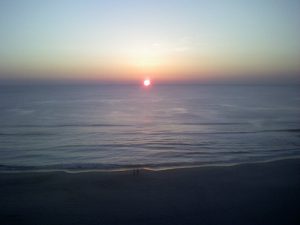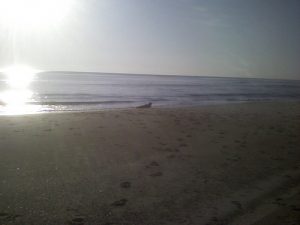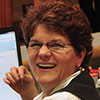This article is more than 5 years old.
Cristina and I have had a taste of the wild life in Virginia Beach in our first 24 hours at the ILLiad International Conference. When we arrived at our hotel on Tuesday, we were greeted by a bird that was camped right outside our door. While surprised, we managed to scare it away so we could get into the room. After we unpacked, then tried a few strategies to rescue the poor frightened bird. Throwing a towel over a skittish bird, while seemingly an easy thing, didn’t work very well. After we gave up, the housekeeping staff jumped into action and must have eventually saved it since it wasn’t in the hall when we went down to dinner. We had a lovely dinner of seafood and pasta at the recommended restaurant, then went for a walk on the boardwalk right outside the hotel. It was a lovely evening, though a little chilly.
This morning dawned bright and beautiful. This is the view from our balcony.  We noticed a commotion on the beach and discovered that a seal had come up on the beach in the night and was enjoying some sun himself. After breakfast, (during which we met up with colleagues from Davidson and UNC-Charlotte), on our way to the conference hotel, we stopped over to say hello to the seal.
We noticed a commotion on the beach and discovered that a seal had come up on the beach in the night and was enjoying some sun himself. After breakfast, (during which we met up with colleagues from Davidson and UNC-Charlotte), on our way to the conference hotel, we stopped over to say hello to the seal.  (The picture might not be too clear, but it really is a seal!) Some staff from the aquarium up the street had come over to caution tape off the area so this is as close as we could get. The woman we talked with said that it’s unusual, but not rare for seals to come up onto Virginia Beach.
(The picture might not be too clear, but it really is a seal!) Some staff from the aquarium up the street had come over to caution tape off the area so this is as close as we could get. The woman we talked with said that it’s unusual, but not rare for seals to come up onto Virginia Beach.
After that morning’s excitement, we had a four block walk over to the conference hotel.
My morning’s sessions were all about ILLiad reporting and how to get relevant data out. Stephanie Spires of Atlas gave a report on Basic ILLiad database tables and relationships. Then she discussed ILLiad webreports and how they are similar and different from the Resource Sharing reports from OCLC. We also learned how to export data from OCLC into Excel for data manipulation and finally, now to export from the ILLiad client into Excel.
Second presenter of the day was John Penn who shared info on OCLC Resource Sharing stats and gave tips on how to make them work better and easier for you. He also showed a really cool tool he used called Geocoding to pull data from ILLiad transactions into a map to visually show where your ILLiad Resource Sharing customers are. Very interesting stuff!
After lunch, Collette Mak gave a real hands on tutorial with how to use data pulled from real ILLiad transactions into Excel and discovered many tips and tricks onto how we can use all kinds of things about the data. Her tutorial allowed us to go beyond what is being requested, to who is requesting what (and when!). She showed us how we might pull transactions reports that target new faculty to see specifically what they are requesting. Her reports can have far reaching implications beyond collection development to discovering different staffing models that will help meet user needs faster, and identify more about those “what the heck is going on?” outliers that skew data.
The pre-conference sessions were so valuable. I can’t wait to try some of the tips I learned on our ILLiad and OCLC data at ZSR! Tonight we are having a reception at the Virginia Aquarium and I fully expect that our wild times, both inside and outside of the conference, will continue.

1 Comment on ‘Birds, Seals and ILLiad reports’
Sounds good so far!